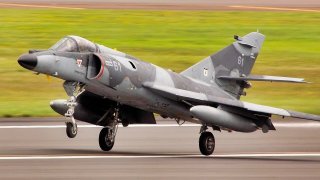Super Étendard: The French-Built Fighter That Sunk A Royal Navy Warship
A total of 85 Dassault-Breguet Super Étendard – French for “Battle Flag” – were produced between 1974 and 1983, and it was over 40 years ago, in May 1982, that the aircraft scored its greatest success.
A total of 85 Dassault-Breguet Super Étendard – French for “Battle Flag” – were produced between 1974 and 1983, and it was over 40 years ago, in May 1982, that the aircraft scored its greatest success.
Yet, it wasn’t with the French Navy, for which the carrier-based strike fighter was first designed, but rather with the Argentine Navy during the Falkland War.
The French-made aircraft had the distinction of successfully sinking a Royal Navy warship.
Introducing the Super Étendard
Development of the Super Étendard began in the late 1960s when the French Navy’s original force of Étendard aircraft was nearing the end of its service life. The Étendard IVM was to have been replaced by a naval variant of the SEPECAT Jaguar, which was designated as the Jaguar M; however, that project was stalled by a combination of political problems and issues experienced during trial deployments onboard carriers.
The result led to the development of the Super Étendard.
It was hardly a leap forward, as the Super Étendard had much lower performance than the Jaguar, while it carried about half the weapon load. For the French government that didn’t seem to matter, as its components were almost 100 percent domestically sourced.
Use With Argentina
Dassault may have had visions of exporting the aircraft around the world, yet Argentina proved to be the only export customer and ordered a total of 14 of the strike fighters for use on its sole aircraft carrier. Only five Super Étendard aircraft had been delivered by the time Argentina seized the Falkland Islands, and only four of those were operational.
Those aircraft were in service with the 2 Escuadrilla, 3 Escuadra Aéronaval, based at Rio Grande, Tierra del Fuego. The planes were brand new and the pilots had only recently completed their training in France, but it was soon apparent that neither side was ready to fight an early winter war in the South Atlantic, but war it was to be.
The first attempt was made to attack the British fleet as it approached the Falklands on May 2, 1982 – but it was canceled due to an in-flight refueling problem. That day the Royal Navy submarine Conqueror scored a major victory when it sunk the Argentine Navy’s light cruiser General Belgrano.
Two days later, a pair of Super Étendard strike fighters took part in what would be Argentina’s only notable victory of the war. It was seen by some as payback for the loss of the cruiser.
The Sinking of the HMS Sheffield
At about 1,000 hours (1:00 am local time), the Argentine aircraft, flying how and fast to escape radar detection, launched two Exocet sea-skimming missiles towards the carrier Hermes, which was stationed some 60 nautical miles to the south of Port Stanley. One failed to find a target, but the other successfully homed in on the HMS Sheffield, a Type 42 destroyer on radar picket duty ahead of the carrier. The Sheffield‘s onboard radar only picked up the Exocets 10 seconds before the missile slammed into its stern.
It was too late to react.
Although the warhead itself may not have exploded, the impact was enough to start fires that soon ran out of control. Twenty sailors were killed in the attack, and Sheffield had to be abandoned. She floundered while under tow on May 10 and was the largest Royal Navy warship lost since the Second World War
In many ways, that action vindicated the Super Étendard’s reputation, and the aircraft went on to see years of reliable service with the French Navy, with 16 each serving in the carrier air wings of the French aircraft carriers Foch and Clemenceau, and later the Charles de Gaulle.
Even today, Argentina reportedly maintains a few of the upgraded Cold War-era aircraft. And likely with good reason: what other aircraft of the post-World War II can lay claim to sinking a Royal Navy vessel?
About the Author
Peter Suciu is a Michigan-based writer who has contributed to more than four dozen magazines, newspapers and websites. He regularly writes about military hardware, and is the author of several books on military headgear including A Gallery of Military Headdress, which is available on Amazon.com. Peter is also a Contributing Writer for Forbes.


